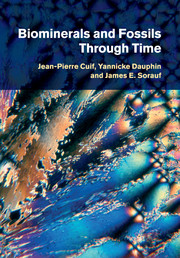Book contents
- Frontmatter
- Contents
- Preface
- Introduction: Milestones in the study of biominerals
- 1 The concept of microstructural sequence exemplified by mollusc shells and coral skeletons
- 2 Compositional data on mollusc shells and coral skeletons
- 3 Origin of microstructural diversity
- 4 Diversity of structural patterns and growth modes in skeletal Ca-carbonate of some plants and animals
- 5 Connecting the Layered Growth and Crystallization model to chemical and physiological approaches
- 6 Microcrystalline and amorphous biominerals in bones, teeth, and siliceous structures
- 7 Collecting better data from the fossil record through the critical analysis of fossilized biominerals
- 8 Results and perspectives
- List of references
- Name index
- Subject index
8 - Results and perspectives
Published online by Cambridge University Press: 10 January 2011
- Frontmatter
- Contents
- Preface
- Introduction: Milestones in the study of biominerals
- 1 The concept of microstructural sequence exemplified by mollusc shells and coral skeletons
- 2 Compositional data on mollusc shells and coral skeletons
- 3 Origin of microstructural diversity
- 4 Diversity of structural patterns and growth modes in skeletal Ca-carbonate of some plants and animals
- 5 Connecting the Layered Growth and Crystallization model to chemical and physiological approaches
- 6 Microcrystalline and amorphous biominerals in bones, teeth, and siliceous structures
- 7 Collecting better data from the fossil record through the critical analysis of fossilized biominerals
- 8 Results and perspectives
- List of references
- Name index
- Subject index
Summary
The result of the initial step that began simply by comparing two types of calcium-carbonate material deposited by biological mechanisms (generally accepted as distinct), this study has moved far afield. Although not yet finished, this research provides truly convergent data regarding the methods of skeletal development that have resulted in calcareous structures produced by organisms. Now it is possible to suggest a generalized model for this biomineralization. The model essentially covers structures produced by epithelial mineralization, but, as this is a broadly shared type of calcification, the model pertains to most invertebrate animals. Coccoliths, unicellular algae with mineralization occurring within Golgi-derived vesicles, are the most notable exception.
In contrast to classical analysis of shell structures that were and are based on descriptions of the sizes and shapes of various mineralized units forming different and distinct shell layers, the methods used here focus rather on the introduction of time being an essential element of microstructural analysis. Determining what is synchronous in diverse structures, and still more informative, imaging the mineralized layers that contain actual evidence of the activity of mineralizing organs, now leads to examination of these deposits from a fresh viewpoint, far removed from the traditional approach.
According to this method, the actual growth unit is clearly a mineralized layer and a significant part of this study has been dedicated to the description of the structure and composition of exactly what the biomineralization unit is.
- Type
- Chapter
- Information
- Biominerals and Fossils Through Time , pp. 435 - 438Publisher: Cambridge University PressPrint publication year: 2010



